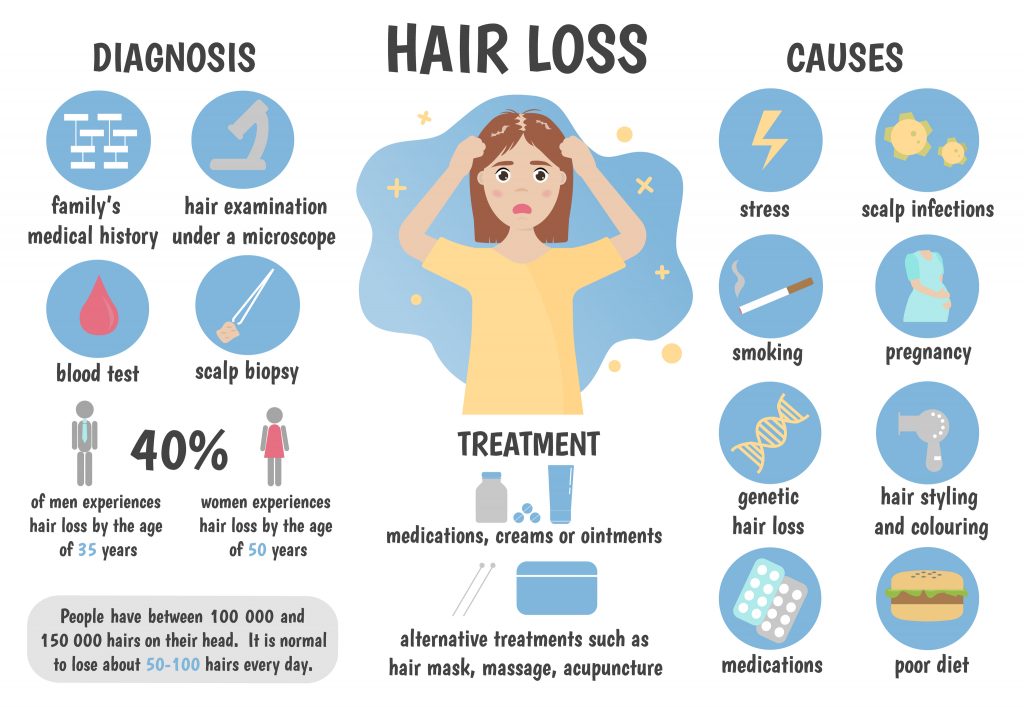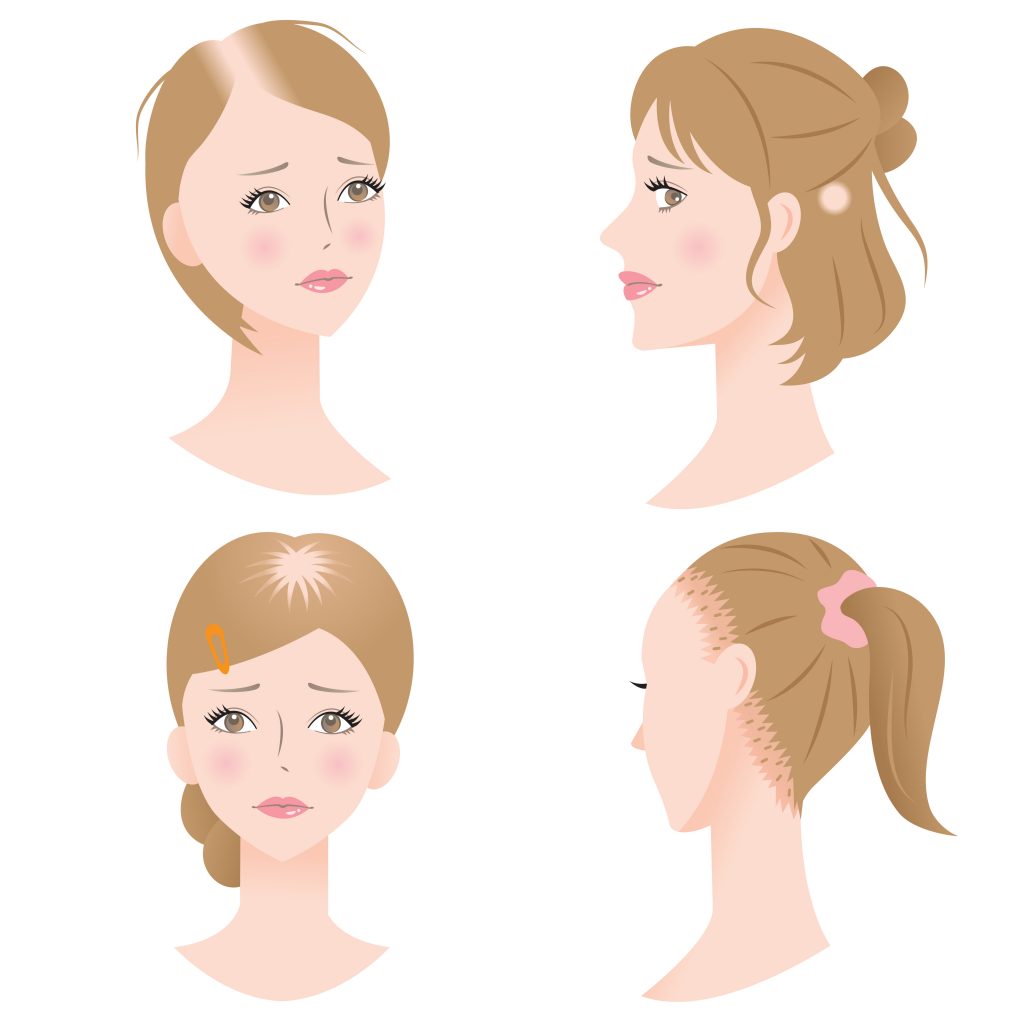Diagnosis of Hair Loss in Women
How to Diagnosis of Hair Loss in Women/Female
Diagnosis of hair loss in women is not as simple as it is for men. Apart from family or medical history that typically highlights genetic hair loss in females, there are lots more for the diagnosis of varied causes. The distinguished diagnoses for hair loss in women are classified into three categories i.e.:-
- Disruption in the hair cycle
- Damage to the hair shaft
- Disorders or medical conditions affecting the follicle.
Chronic Telogen effluvium: In Telogen effluvium, the majority of hair on the scalp is usually in the growth phase, with a little number of hairs in the resting phase falling out daily (50-100). Some women may even observe a sudden onset of marked shedding.
The exam generally uncovers “normal” hair volume and fair scalp coverage of global exam, as more than 50% of the hair must be lost before hair loss is clinically manifested.
Hair Loss Causes
If the patient is analyzed when the hair loss is apparently active, the pull test may prove to be positive, or else hair re-growth with tapered ends may be seen.
- Common causes include thyroid disorder, childbirth, severe chronic illness, severe infections; severe “flu,” protein deficiency, and specific drug intake.
- The shedding is often self-restricted and reversible. The biology of telogen effluvium can be well understood as the hair cycle is more or less like a menstrual cycle that can be resolved after a certain span of time.
- Androgenetic alopecia or hereditary hair thinning is the most prevalent cause of hair loss in both women and men. Onset may take place in both sexes at any time after hitting puberty and the majority of thinning occurs in the late teens, 20s, and 30s.
- In hereditary hair loss, there is a steady diminution of the follicle, which occurs under the persuasion of androgens. The smaller hair follicle finally leads to a finer and shorter hair shaft. Miniaturized hairs are its common characteristic.
- Thyroid and iron deficiencies are two occult causes of genetic hair loss in females and that can be conveniently ruled out through laboratory tests.
- Highly advanced laboratory tests are generally not required if the woman with hereditary thinning has absolutely normal pregnancies, menses, and endocrine function.
Hair breakage: Hair is mainly composed of the protein keratin, which is the same substance that develops toenails and fingernails and toenails. Damage to the hair shaft is caused by chemical concentrated or heat-induced techniques or too much tension during weaving.
The Hair loss is usually reversible if the inappropriate styling or hair care practices are discontinued. Tests for Inadequate proteins can be considered in this condition.

Diagnostic Tests for Hair Loss in Women
Before making a diagnosis, the dermatologist is likely to provide a physical examination and confirms the patient’s family or medical history. Quick breakdowns of tests that are conducted to diagnose hair loss in females are as follows-
- Blood test- This aids in disclosing any medical conditions that may be contributing to hair loss, such as thyroid disorder.
- Hair Pull test- In this evaluation, the dermatologist gently pulls around 20 hair strands from the scalp to see how many come out. If more than 3 fall out while tugging then it is a condition of severe hair loss. This also helps in identifying the stage of the shedding process.
- Scalp biopsy. The physician scrapes samples out of the skin or from a few hairs plucked from the scalp to thoroughly assess the hair roots. This can help in examining if an infection is causing hair loss. A small portion of the scalp generally 4mm in diameter is removed and evaluated under a microscope to help identify the actual cause of hair loss.
- Light microscopy. In this, the doctor uses a special device to analyze hairs trimmed at their bases. Microscopy technique helps in the revelation of possible disorders of the hair shaft.
- Densitometry- A handheld magnification device is used to check for miniaturization of the hair shaft.
- Thyroid Testing- This test is conducted to check for thyroid stimulating hormone (T3, T4, TSH)
- Hormone levels- In this, follicular stimulating hormone, testosterone, luteinizing hormone, androstenedione, prolactin, and DHEAs are checked for triggering hair loss.
- TIBC- Total iron binding capacity
- VDRL- A screening test for syphilis
- Serum iron and Serum ferritin
When the cause of the hair loss is still untraceable, expert dermatologic consultation is best recommended.
The doctor send out the hair sample to the lab for special and regular tissue stains and analyzes under both vertical and horizontal sections to obtain further diagnostic information.
Laboratory Evaluation for Androgen Excess in Women
When a woman suffers from female pattern hair loss, excessive androgen production may be a contributing factor, for which diagnosis and treatment may be life-saving.
The following signs and symptoms indicate that particular blood tests might be relevant to rule out the unrevealed mediums of increasing androgen:
- Menstrual cycle abnormalities – Irregular periods for an elongated time period
- Infertility – incapability of giving child-birth or becoming pregnant
- Galactorrhea – breast secretions when not pregnant (this is because of the production of prolactin which is not actually an androgen)
- Hirsutism – excessive increase in body hair that does not naturally run in family
- Virilization – occurrence of secondary male sex features such as an intensified voice
- Cystic acne – Acne problems that leave scars
It is essential to note that when any of these signs or symptoms are prevalent, or these situations are being considered, you are under the consultation of a doctor, to obtain an appropriate examination and accurate treatment if required. Normally, a gynecologist is the specialist most beneficial for these women’s health issues.
Some of the tests that the physician might prescribe to screen increasing androgen include:-
- Free and total Testosterone – the hormone that is predominantly responsible for secondary male sex characteristics
- Prolactin – the hormone that allows the breast to secrete milk
- DHEA-Sulfate – a predecessor to testosterone
Diagnostic Tests for Other Medical Conditions
Other tests that are most often recommended by doctors to rule out underlying medical conditions include:
- Thyroid disease testing – T3, T4, TSH
- CBC (complete blood count) – for assessing blood loss, anemia, and various vitamin inadequacies
- Serum iron and iron binding capacity – for anemia
- ANA – for Lupus
- STS – for Syphilis
Alopecia Areata
Alopecia areata is an autoimmune disorder in which inflammatory cells adversely attack the hair follicle, thus arresting hair growth. In a few cases, there is initially seen a small circular patch of hair and this patch may grow progressively.
In some cases, there can be widespread patchy hair loss (alopecia totalis) and in rare cases, there is hair loss across the entire scalp, eyebrows, lashes, as well as body hair (alopecia universalis). Alopecia areata can occur at all ages, although young adults fall fast for this form of hair loss. As symptoms, the nails may present pitting or track marks.
On deeper physical examination, the regions of hair loss will uncover bare skin with retained follicular markings. The unrevealed scalp may have a little salmon-colored tint to it. A pull test is remarkably positive. Medical treatment for alopecia areata does not change the natural course action of the disease, nor does it halts the development of new patches of alopecia.
However, the treatment options include 5% topical minoxidil, oral corticosteroids intralesional corticosteroid, topical steroid, topical immunotherapy, light treatment, and short-contact anthralin.
The hair loss treatment must be given only after analyzing the severity of hair loss, age and other correlated factors.
Traction Alopecia
 Hairstyles that employ constant pressure on the hair, such as tightly woven braids, tight pulled back pony or “corn rows”. It shows a characteristic pattern called “Traction Alopecia” that can be determined by a circumference of balding or thinning at the temples or alongside the frontal hairline. This is simply cured by modifying one’s hair-care practices or wearing loose hair.
Hairstyles that employ constant pressure on the hair, such as tightly woven braids, tight pulled back pony or “corn rows”. It shows a characteristic pattern called “Traction Alopecia” that can be determined by a circumference of balding or thinning at the temples or alongside the frontal hairline. This is simply cured by modifying one’s hair-care practices or wearing loose hair.
However, it is important to note that once the hair loss occurs and continues to prevail for an extended period of time, it may become permanent. Luckily, this condition is purely receptive to surgery if the cause can be removed.
Trichotillomania
Trichotillomania is a hair disorder that occurs most commonly in young females, due to their habit of consistently twisting, pulling, tugging, or plucking out their hair. This can be head hair, eyelashes, or eyebrows. The diagnosis is generally made by noticing broken, finer or short hairs in the area of hair loss. Few patients may refuse to have this habit.
Face-lift & Brow-lift Procedures
Face-lift and brow-lift cosmetic procedures may lead to local hair loss in the proximity of the incision. This condition characterizes hair loss in a surgical scar domain, at the temples, or along the frontal hairline. If a woman does not have hereditary hair loss and possesses a good donor supply, she stands ideally eligible for a hair transplant.
Tinea Capitis
Tinea Capitis is caused by a fungal infection in the scalp. It shows small bald patches, broken hairs, redness, and irregular scaly patches. The diagnosis is established by scraping a small portion of scale from the head and receiving a little amount of hair for testing. The specimens are being sent to labs for special fungal stains and cultures.
Pseudo Palade
Pseudo Palade is a non-specific scarring alopecia that usually begins at the top of the head and stretches into the hair-bearing adjacent areas with finger-like extensions. The areas appear white and smooth because of the loss of hair follicles and scarring.
Lichen Plano-pilaris
Lichen Plano-pilaris is a form of inflammatory scalp condition that is characterized by local areas of hair loss, scaling, and redness. There is an evident feature of scaling at the edge of each bald patch.
Discoid Lupus Erythematosus (DLE)
Discoid Lupus Erythematosus (DLE) is a localized kind of Systemic Lupus Erythematosus (SLE), a competently consequential autoimmune disease. The localized form exhibits scarred skin, scaly, pigmented patches, or redness.
The localized form of the disease is commonly a cosmetic issue, but the person must be examined for the systemic disease as well with certain blood tests like ANA. DLE can even be responsible for causing diffuse (generalized) hair loss and both the local and systemic forms of the disease may enkindle sensitivity to the sun.
Dr. Sandeep Bhasin
Dr. Sandeep Bhasin is a highly skilled cosmetic surgeon and the owner of Care Well Medical Centre in Delhi. With extensive expertise in cosmetic and plastic surgery, he is dedicated to providing exceptional care and transformative results to his patients. Dr. Sandeep Bhasin obtained his MBBS and MS in General Surgery from Aligarh Muslim University (AMU) and served as a consultant at Bhaktshreshtha Kamalakarpant Laxman Walawalkar Hospital, Diagnostic & Research Centre. Specializing in various procedures such as face-lifts, rhinoplasty, liposuction, breast augmentation, hair transplant and many others, Dr. Sandeep Bhasin is committed to enhancing his patients' natural beauty and self-confidence.
